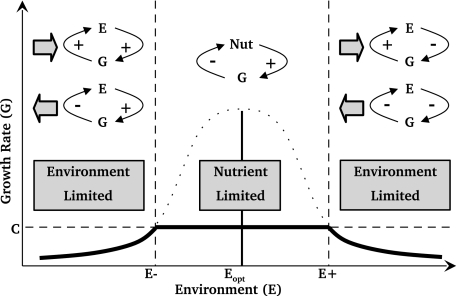Fig. 4.
Schematic of nutrient-limited and environment-limited feedback regimes in relation to the growth response of microbes to the state of the abiotic environment. The boundaries between regimes occur at the boundaries of the habitable region, that is, at the states of the abiotic environment at which microbe growth rate (dotted line) exactly balances maintenance cost (C, horizontal dashed line). This relation provides upper (E+) and lower (E−) habitability bounds (vertical dashed lines) on the abiotic environmental variable (E) on either side of the growth optimum (Eopt, vertical solid line). The dotted line shows the hypothetical growth rate of microbes permitted by abiotic conditions if there were no nutrient limitation. The actual microbe growth rate (solid black line) takes into account both nutrient and environmental constraints. In the nutrient-limited regime (between E− and E+), negative feedback on growth occurs in which nutrient availability increases growth, which decreases nutrient availability. In the environment-limited regimes (above E+ or below E−), there is a symmetrical difference between the feedback structures above and below the growth optimum. When population growth causes net increase in E (right arrows), there is positive feedback on growth below E− (where growth improves the environment and increases growth rate) and negative feedback on growth above E+ (where growth degrades the environment and decreases growth rate). When population growth causes net decrease in E (left arrows), there is negative feedback on growth below E− and positive feedback on growth above E+.

